A REPORT BY
THE SECRETARY TO THE TREASURY AND
THE SECRETARY TO THE DEPARTMENT OF FINANCE AND ADMINISTRATION
October 2001
© Commonwealth of Australia 2001
ISBN 0 642 74089 5
This work is copyright. Apart from any use as permitted under the Copyright Act 1968, no part may be reproduced by any process without prior written permission from the Commonwealth available from Info Products. Requests and inquiries concerning reproduction and rights should be addressed to the Manager, Legislative Services, Info Products, Finance, GPO Box 1920, Canberra ACT 2601.
Printed by Canprint Communications Pty Ltd
Foreword
The Charter of Budget Honesty Act 1998 (the Charter) provides for the Secretaries of the Departments of the Treasury and of Finance and Administration (the Secretaries) to publicly release a Pre-Election Economic and Fiscal Outlook report (PEFO) within ten days of the issue of the writ for a general election. Such a writ was issued on 8 October 2001.
The purpose of the PEFO is to provide updated information on the economic and fiscal outlook. The information in the report takes into account, to the fullest extent possible, all Government decisions made before the issue of the writ and all other circumstances that may have a material effect on the fiscal and economic outlook.
In recognition of the limited time available to prepare the PEFO, the Charter provides that information which is unchanged from that provided in an earlier economic and fiscal outlook report may be summarised in the PEFO.
The 2001 PEFO updates the estimates contained in the 2001-02 Budget. It includes information contained in the June quarter national accounts, and all decisions taken by the Government since the 2001-02 Budget.
Consistent with the Charter's requirements, the PEFO:
- provides an updated fiscal outlook;
- presents the updated economic forecasts which underpin the revised expenses, capital and revenue estimates;
- summarises the changes in the expenses, capital and revenue estimates;
- provides in Appendix A a summary of the external reporting standards used in the preparation of the PEFO, and updated financial statements;
- lists in Appendix B the policy decisions taken by the Government since the 2001-02 Budget;
- updates in Appendix C the general and specific risks to the forward budget estimates for material changes in these risks since the 2001-02 Budget; and
- discusses in Appendix D the sensitivity of the forward budget estimates to changes in major economic parameters.
Statement by the Treasurer and the Minister for Finance and Administration
Consistent with the Charter of Budget Honesty Act 1998, we declare that we have disclosed to the Secretary to the Treasury and the Secretary to the Department of Finance and Administration all details of any Government decision, or any other circumstance, that we know about:
(i) that has, or could have, material fiscal or economic implications; and
(ii) that neither of the responsible Secretaries could reasonably be expected to know about.
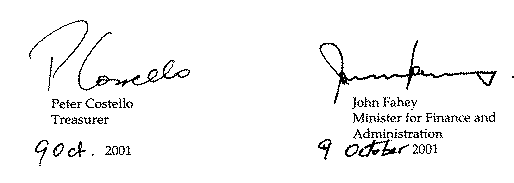
Statement by the Secretary to the Treasury and the Secretary to the Department of Finance and Administration
Consistent with the Charter of Budget Honesty Act 1998, we declare that, to the fullest extent possible, the information in the Pre-Election Economic and Fiscal Outlook 2001 for which we are responsible:
(i) reflects the best professional judgement of the officers of the Treasury and the Department of Finance and Administration;
(ii) takes into account all economic and fiscal information available; and
(iii) incorporates the fiscal implications of Government decisions and circumstances disclosed by the responsible Ministers.

Contents
Pre-Election Economic and Fiscal Outlook
Appendix A: External Reporting Standards and Financial Statements
Government Finance Statistics statements
AAS31 Financial Reporting by Governments statements
Appendix B: Summary of policy decisions
Appendix C: Statement of risks
Appendix D: Sensitivity of fiscal aggregates to economic developments
(a) The following definitions are used in the PEFO:
- `real' means adjusted for the effect of inflation;
- real growth in expenses is measured by the non-farm Gross Domestic Product (GDP) deflator;
- the budget year refers to 2001-02, while the forward years refer to 2002-03, 2003-04 and 2004-05; and
- one billion is equal to one thousand million.
(b) Figures in tables and generally in the text have been rounded. Discrepancies in tables between totals and sums of components are due to rounding:
- estimates under $100,000 are rounded to the nearest thousand;
- estimates $100,000 and over are generally rounded to the nearest tenth of a million;
- estimates midway between rounding points are rounded up; and
- the percentage changes in statistical tables are calculated using unrounded data.
(c) For the budget balance, a negative sign indicates a deficit while no sign indicates a surplus.
(e) The following notations are used:
NEC/nec not elsewhere classified
AEST Australian Eastern Standard Time
- nil
.. not zero, but rounded to zero
na not applicable (unless otherwise specified)
nfp not for publication
$m $ million
$b $ billion
(f) References to the `States' or `each State' include Territories. The Australian Capital Territory and the Northern Territory are referred to as `the Territories'. The following abbreviations are used for the names of the States, where appropriate:
NSW New South Wales
VIC/Vic Victoria
QLD/Qld Queensland
WA Western Australia
SA South Australia
TAS/Tas Tasmania
ACT Australian Capital Territory
NT Northern Territory
Pre-Election Economic and Fiscal Outlook
The Australian economy is expected to continue to record solid economic growth and low inflation in 2001-02, despite a much weaker and more uncertain global economic environment.
As outlined in the Mid-Year Economic and Fiscal Outlook 2001-02 (MYEFO), the underlying cash balance is expected to be in surplus in 2001-02 and the forward years. In accrual terms, the fiscal balance is expected to be in deficit in 2001-02 and 2002-03, before returning to surplus in 2003-04.
Table 1 provides revised estimates and projections of the underlying cash and fiscal balances for the period from 2001-02 to 2004-05. These are unchanged from those published in the 2001-02 MYEFO.
Table 1: Summary of budget aggregates
The Australian economy is expected to grow by around 3 per cent in 2001-02 in year-average terms, down slightly from the 3¼ per cent growth forecast at Budget. In through-the-year terms to the June quarter 2002, growth has been revised down from 4 per cent at Budget to 3¼ per cent. These forecasts are a little below Australia's long-term average growth rate, with the downward revisions mainly reflecting the expected impact of a much weaker global economic environment.
The outlook for world economic growth has deteriorated sharply since the Budget. Some of the downside risks identified at Budget had already come into play prior to the terrorist attacks in the United States on 11 September, with the first major downturn since the early 1990s already underway. The terrorist attacks created additional uncertainty and increased the likelihood of a deeper and more prolonged period of global weakness.
The world economy is now expected to grow by around 2¼ per cent in 2001, down significantly from 3¼ per cent expected at Budget, and down sharply from the 4.7 per cent growth recorded in 2000. This would be the lowest global growth rate since the early 1990s. World economic growth is expected to recover during 2002, to be 2½ per cent, rising to 3½ per cent in 2003. Growth in Australia's major trading partners is expected to be weaker still, at ¾ of a per cent in 2001 and 1½ per cent in 2002, the weakest pace of growth in any two-year period in the last three decades.
While the international outlook is now much weaker, some components of domestic demand are expected to grow more quickly than forecast at Budget, which should ameliorate the impact on overall economic growth to some extent. In particular, dwelling investment is likely to grow very strongly, while public demand is also now likely to be stronger than at Budget.
The more pronounced weakness and uncertainty surrounding the global economic outlook, combined with some recent business collapses in Australia, has led to domestic business and consumer confidence declining from recent above-average levels. In turn, this may result in businesses delaying investment plans in plant and equipment, stock rebuilding, and the employment of new staff.
Lower employment growth, the impact of the recent decline in share prices on household wealth, and lower levels of consumer confidence are all expected to have a dampening influence on household consumer spending in 2001-02. Recent declines in official interest rates and lower oil prices are, however, likely to provide a partial offset.
Domestic demand is now forecast to grow by 3¾ per cent in 2001-02, with net exports expected to detract around ¾ of a percentage point from overall economic growth. At Budget, domestic demand was forecast to grow by 3 per cent, with net exports forecast to contribute a further ¼ of a percentage point to growth.
In light of these developments, employment growth is now forecast to be ¾ of a per cent in 2001-02 in year-average terms, compared with 1 per cent growth expected at Budget. The unemployment rate is forecast to be around 7 per cent in the June quarter 2002, unchanged from Budget, reflecting a more muted rise in labour force participation.
The headline Consumer Price Index (CPI) is forecast to increase by around 2¾ per cent in 2001-02 in year-average terms, compared with a 2 per cent increase forecast at Budget. The upward revision to the CPI mainly reflects the expected impact of a number of one-off factors, rather than representing any significant increase in ongoing inflationary pressures. In particular, higher insurance premiums, electricity prices, meat prices and domestic airfares are expected to put upward pressure on the CPI relative to earlier expectations. The recent modest decline in the exchange rate, if sustained, could also increase the CPI slightly over coming quarters. On the other hand, weak world growth and ongoing unused domestic capacity should help to contain inflationary pressures.
Reflecting the impact of weak growth in Australia's export markets, the current account deficit is forecast to increase to around 3¾ per cent of GDP in 2001-02, somewhat higher than the 3 per cent forecast at Budget, but significantly below the long-term average.
With a forecast gradual recovery in world economic growth as 2002 proceeds, and with world growth expected to return to around trend rates of growth in 2003, a strengthening in activity is likely in Australia in 2002-03. GDP growth in Australia is expected to increase to 3½ per cent in 2002-03 in year-average terms and a strong 4¼ per cent in through-the-year terms, facilitated by accommodative monetary and fiscal policies. Employment growth is expected to increase to 1¼ per cent, while inflation is expected to remain comfortably within the Reserve Bank's target zone at around 2½ per cent. Business investment and household consumer spending are both expected to grow solidly in 2002-03.
Table 2 presents the major economic parameters which underpin the Pre-Election Economic and Fiscal Outlook 2001 (PEFO) financial estimates. The parameters for 2001-02 and 2002-03 are Treasury forecasts, while the parameters for 2003-04 and 2004-05 are projections based on long-term average growth rates, consistent with the usual conventions used in the Budget.
Table 2: Major economic parameters (percentage change from previous year)

(a) Labour Force Survey basis.
(b) Average earnings (national accounts basis).
There continue to be major uncertainties surrounding the economic outlook.
- Ongoing uncertainty could see the current US cyclical downturn gather momentum. This would have adverse effects on other countries, particularly Australia's major trading partners in the Asia region. The downturn would be exacerbated by a further escalation of international tensions, disorderly adjustment in financial markets or by higher oil prices. In the short-term, the balance of risks is probably on the downside. Any of these factors would act as a further brake on Australian growth.
- On the other hand, if the current uncertainty dissipates quickly, growth in the US and elsewhere could rebound sooner, and at a faster pace, supported by the fiscal and monetary policy stimulus now in train and a restoration of business and consumer confidence. Under these circumstances, and given the competitive exchange rate, Australia's exports would be stronger than forecast and, with very low interest rates and a recovery in confidence, consumption and investment in Australia could rebound rapidly. The result would be substantially stronger domestic economic growth on average across 2001-02 and 2002-03 than currently forecast.
An underlying cash surplus of $0.5 billion, or 0.1 per cent of GDP, is forecast in 2001-02. The fiscal outlook is for further underlying cash surpluses in the forward years.
In accrual terms, a fiscal deficit of $3.1 billion is forecast for 2001-02, or -0.4 per cent of GDP. A fiscal balance deficit is also expected in 2002-03, with surpluses projected for 2003-04 and 2004-05.
Table 3 provides a summary of the major budget aggregates.
Table 3: Commonwealth general government budget aggregates(a)
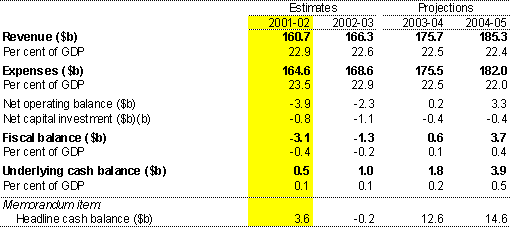
(a) All estimates are based on Government Finance Statistics (GFS) standards, but with goods and services tax (GST) revenue collected on behalf of the States and Territories netted off revenue and expenses.
(b) Net capital investment is defined as net acquisition of non-financial assets.
Table 4 provides a reconciliation between the fiscal balance estimates published in the 2001-02 Budget and the 2001 PEFO.
Table 4: Reconciliation of 2001-02 Budget and 2001 PEFO fiscal balance estimates(a)
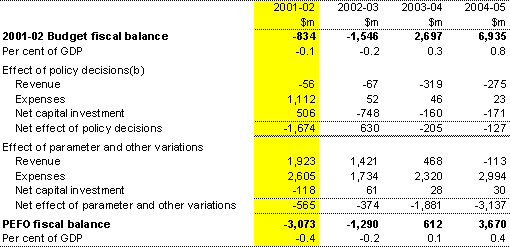
(a) A positive number for revenue indicates an increase in the fiscal balance, while a positive number for expenses and net capital investment indicates a decrease in the fiscal balance.
(b) Excludes the public debt net interest effect of policy measures.
Relative to the 2001-02 Budget, total Commonwealth general government revenue has been revised up in 2001-02 by $1.9 billion. The major influences on the revenue outlook are the flow-on effects of a stronger revenue base in 2000-01 and continued strength in collections to end-September 2001, partly offset from 2002-03 by the effects of weaker forecast nominal GDP growth. As a consequence of these influences, total revenue has been revised up in all years other than in 2004-05.
Estimated expenses in 2001-02 have increased by $3.7 billion since Budget. This increase reflects the combined effect of economic parameter variations, including the impact of higher than previously anticipated prices and wages growth in 2001-02, new policy measures, and a range of programme specific parameter and other variations. Estimated expenses have also been revised upwards since the 2001-02 Budget in 2002-03 and the following two years.
Forecast net capital investment in 2001-02 has increased by $0.4 billion since the 2001-02 Budget. This increase largely reflects the rescheduling of some Defence property sales from 2001-02 to 2002-03 (proceeds from the sale of non-financial assets, including property, reduce net capital investment and boost the fiscal balance). Higher anticipated property sales in 2002-03 and the following two years have resulted in downward revisions to projected net capital investment in those years since Budget.
Further information on changes in the fiscal estimates since the 2001-02 Budget is provided in the Mid-Year Economic and Fiscal Outlook 2001-02 (MYEFO).
Appendix A provides summary financial statements on both a Government Finance Statistics (GFS) basis and an Australian Accounting Standards (AAS31) basis. Appendix B provides a summary of policy measures taken from the 2001-02 Budget to the commencement of the caretaker period on 8 October 2001.
Appendix A: External Reporting Standards and Financial Statements
This appendix describes the external reporting standards upon which this report is based, and financial statements for the Commonwealth General Government Sector, presented in accordance with those standards. The standards are consistent with those used in 2001-02 Budget and the 2001-02 MYEFO.
The major external standards used in this report are the Australian Bureau of Statistics (ABS) accrual Government Finance Statistics (GFS) framework and Australian Accounting Standards, including Australian Accounting Standard No. 31 Financial Reporting by Governments (AAS31). The estimates provided in this report are generally consistent with these standards, with the following exceptions.
The draft ABS GFS publication Australian System of Government Finance Statistics: Concepts, Sources and Methods (Cat. No. 5514.0) requires that provisions for bad and doubtful debts be excluded from the balance sheet. This treatment has not been adopted in this report because excluding such provisions would overstate the value of Commonwealth assets in the balance sheet (and would therefore be inconsistent with the market valuation principle).
The GFS framework also requires that flows and stocks are valued at current market prices (or where these are not observable, a suitable proxy indicator). However, as outlined in the budget papers, not all assets and liabilities in the Commonwealth's GFS balance sheet are currently valued at current market prices. This is principally because Australian Accounting Standards allow reporting entities to elect to value their assets at either cost or fair value (current market value).
In relation to taxation revenue, the relevant external reporting standards suggest that accrual revenue be recognised at the time the income (or economic activity) giving rise to a tax liability occurs, where this can be measured reliably. The budget papers note that at this stage it is not considered that taxation revenues can be reliably measured on this basis for budget reporting purposes. Accrual taxation revenue in this report is therefore recognised at the time a taxpayer makes a self-assessment or when the Australian Taxation Office or the Australian Customs Service raises a tax assessment.
Finally, consistent with the presentation adopted by the Government in the Budget, Commonwealth revenue and expenses estimates in the main body of this report (and in the AAS31 financial statements below) do not include goods and services tax (GST) collections and equivalent payments to the States. However, in line with the Budget presentation, the GST is recorded as a Commonwealth revenue and the equivalent payments to the States as Commonwealth expenses in the GFS financial statements presented in this appendix.
Additional information on external reporting standards and budget concepts applied in this report is provided in Appendix D of the 2001-02 MYEFO.
Government Finance Statistics statements
Table A1: Commonwealth general government operating statement - GFS
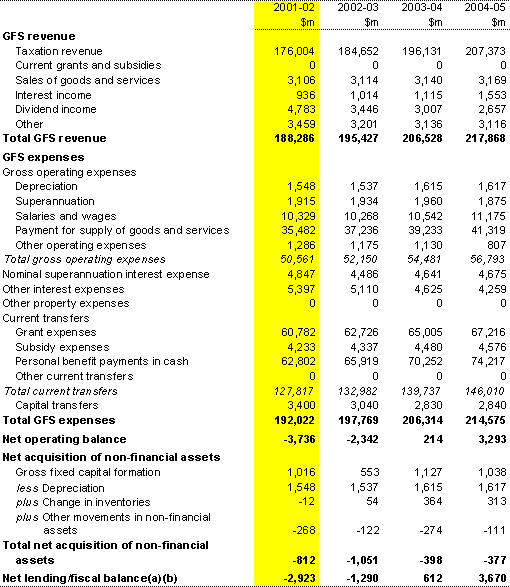
(a) GFS net lending also equals net transactions in financial assets less net transactions in liabilities. The term `fiscal balance' is not used by the ABS.
(b) The fiscal balance and net operating balance estimates for 2001-02 in this table are $150 million greater than the 2001-02 fiscal balance and net operating balance estimates in the fiscal outlook section of the PEFO. This represents GST revenue accrued in 2001-02 but not yet paid to the States (as GST is paid to the States on a cash basis). Under the State tax treatment applied elsewhere in this document, GST revenue accrued is offset by an equivalent amount payable to the States. Further information is provided in Attachment A to Part I of the Final Budget Outcome 2000-01.
Table A2: Commonwealth general government balance sheet - GFS
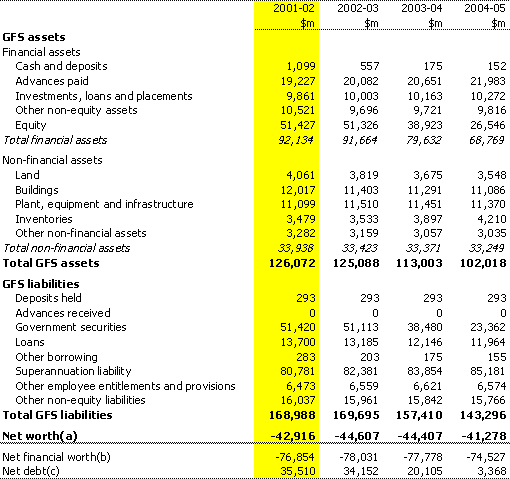
(a) Net worth is calculated as assets minus liabilities.
(b) Net financial worth equals total financial assets minus total liabilities.
(c) Net debt equals the sum of deposits held, advances received, government securities, loans and other borrowing, minus the sum of cash and deposits, advances paid, and investments, loans and placements.
Table A3: Commonwealth general government cash flow statement - GFS(a)
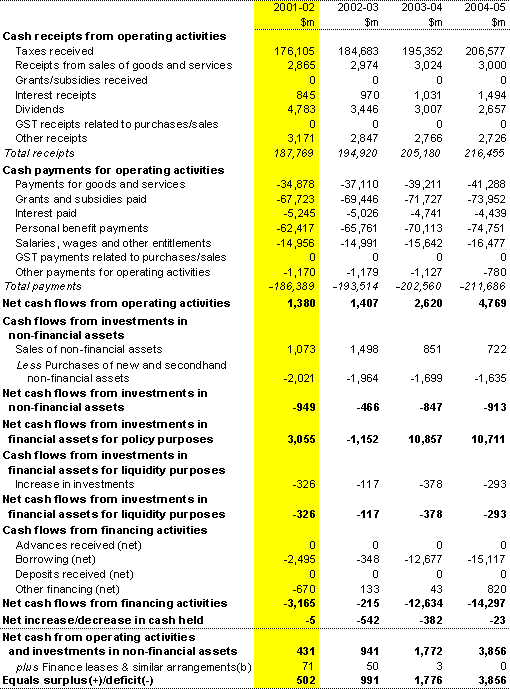
(a) A positive number denotes a cash inflow, and negative number denotes a cash outflow.
(b) The acquisition of assets under finance leases reduces the surplus/deficit.
AAS31 Financial Reporting by Governments statements
Table A4: Statement of revenue and expenses for the Commonwealth general government sector - AAS31
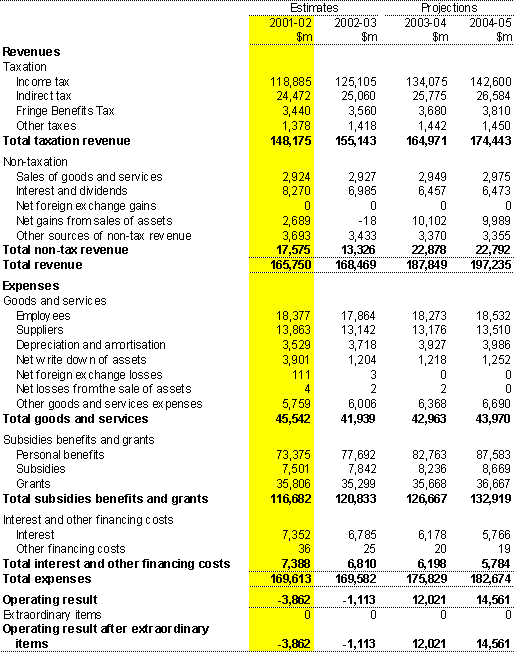
Table A5: Balance sheet for the Commonwealth general government sector - AAS31
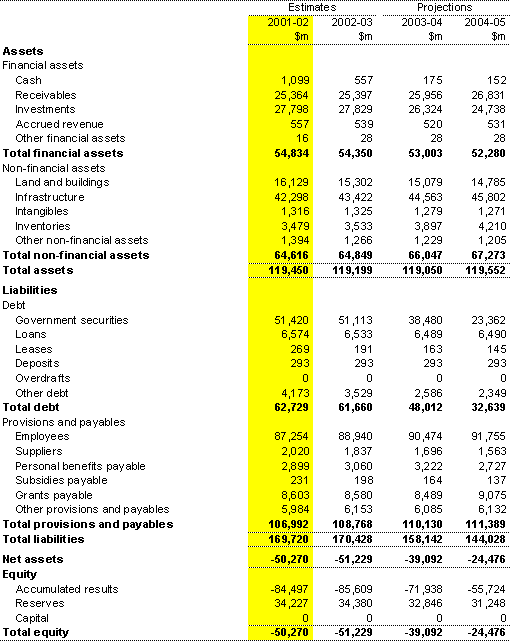
Table A6: Statement of cash flows for the Commonwealth general government sector - AAS31
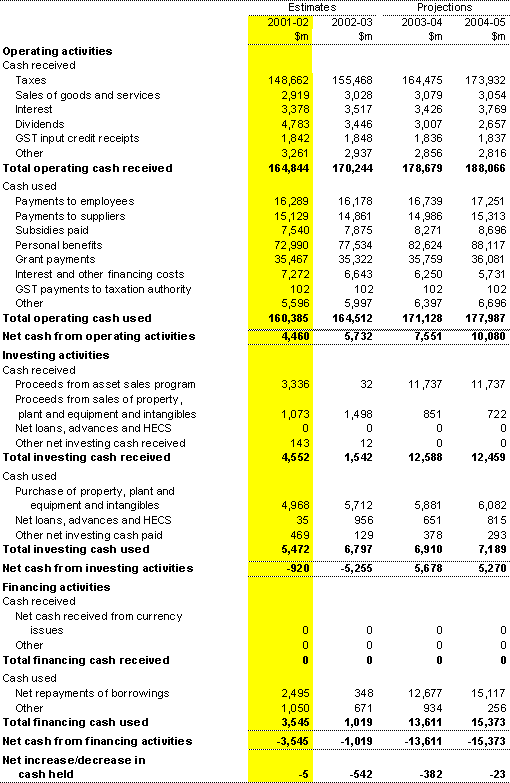
Appendix B: Summary of policy decisions
Table B1: Revenue measures since the 2001-02 Budget(a)
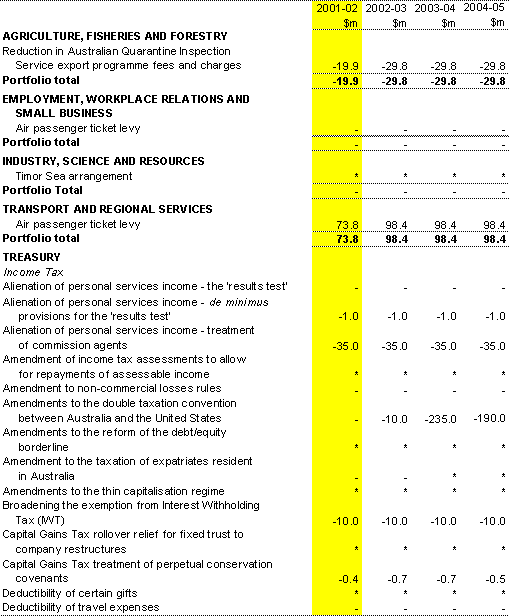
Table B1: Revenue measures since the 2001-02 Budget (continued)(a)
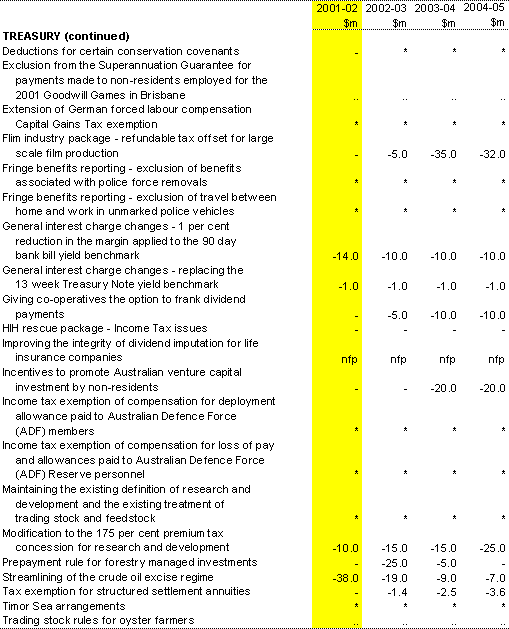
Table B1: Revenue measures since the 2001-02 Budget (continued)(a)
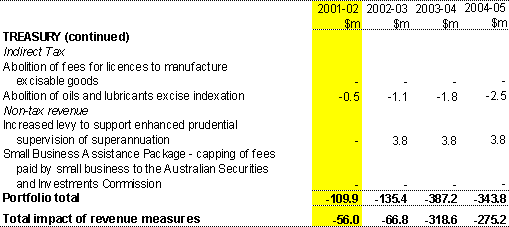
(a) A minus sign before an estimate indicates a reduction in revenue, no sign before an estimate indicates a gain to revenue.
* The nature of the measure is such that a reliable estimate cannot be provided.
Table B2: Expense measures since the 2001-02 Budget
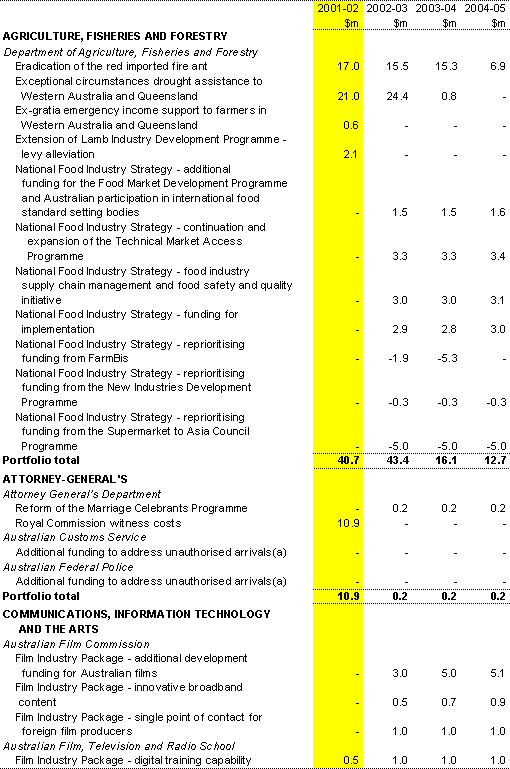
Table B2: Expense measures since the 2001-02 Budget (continued)
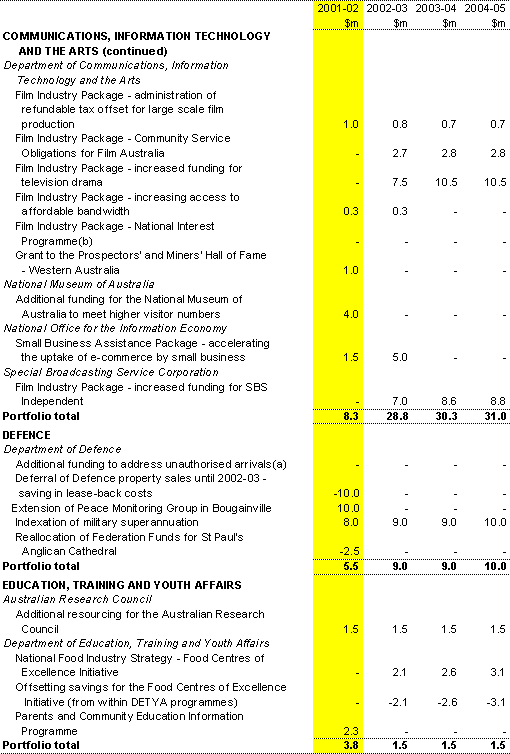
Table B2: Expense measures since the 2001-02 Budget (continued)
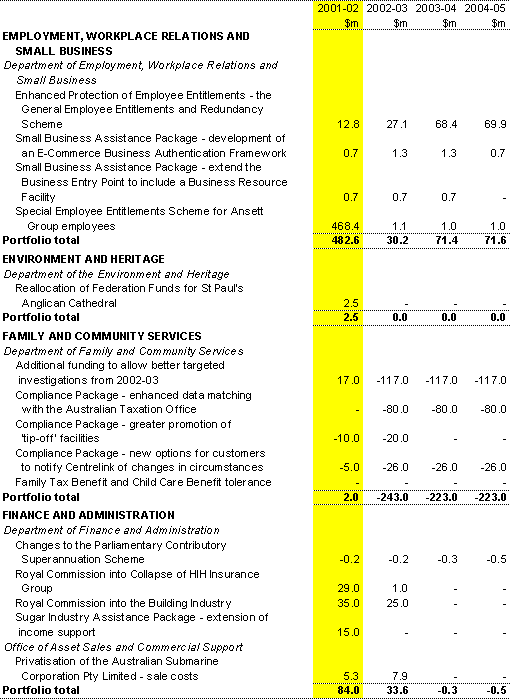
Table B2: Expense measures since the 2001-02 Budget (continued)
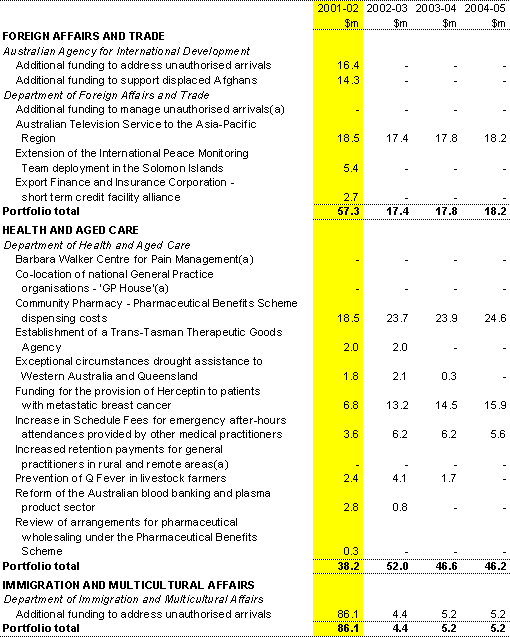
Table B2: Expense measures since the 2001-02 Budget (continued)
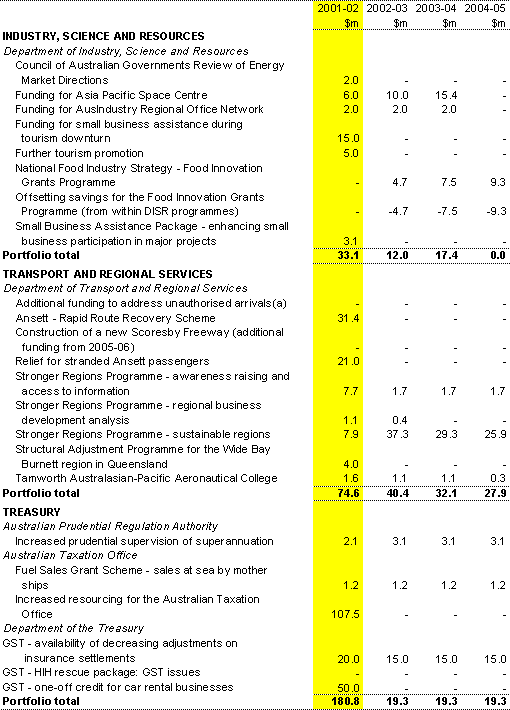
Table B2: Expense measures since the 2001-02 Budget (continued)

(a) The additional costs of this measure are shown as zero in the table, as these costs are to be absorbed within the agency's existing resourcing.
(b) The additional costs of this measure are shown as zero in the table, as the measure represents the renewal of a lapsing programme for which funding is already included in the forward estimates.
Table B3: Capital measures since the 2001-02 Budget
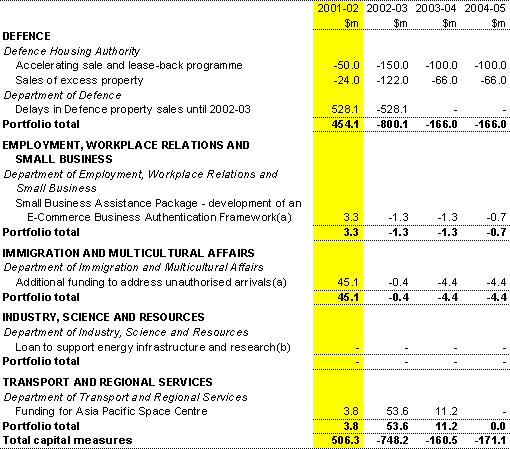
(a) The negative amounts in the forward years reflect depreciation on the initial capital investment.
(b) Loan transactions affect the Commonwealth's investments in financial assets, and for this reason, are shown as having no impact on the fiscal balance.
Appendix C: Statement of risks
Full details of fiscal risks and contingent liabilities are provided in Statement 10 of Budget Paper No. 1 - Budget Strategy and Outlook 2001-02. The Statement of Risks included in the PEFO is consistent with that published in the 2001-02 MYEFO.
The forward estimates of revenue and expenses in the PEFO incorporate assumptions and judgements based on information at the time of publication. A range of factors may influence the actual budget outcome in future years. The Charter of Budget Honesty Act 1998 requires that these be disclosed in each Economic and Fiscal Outlook report.
Events that could affect fiscal outcomes include:
- changes in economic and other parameters;
- matters which have not been included in the fiscal forecasts because of uncertainty about their timing, magnitude or whether they will eventuate; and
- realisation of contingent liabilities.
Economic and other parameters
Some degree of uncertainty is attached to estimates of both revenue and expenses. The major factor influencing expected expenses and revenue in any year is typically changes in forecasts of economic and non-economic parameters. Over time, differences between the economic parameter forecasts and outcomes have not caused any clear bias toward understatement or overstatement of expenses and revenue - and therefore the budget balance. The sensitivity of the estimates to major economic parameters (but not other parameters) is discussed earlier in this Appendix.
Fiscal risks
Fiscal risks are general developments or specific events that may have an effect on the fiscal outlook. In some cases, the events will simply raise the possibility of some fiscal impact. In other cases, some fiscal impact will be reasonably certain, but it will not be included in the forward estimates because the timing or magnitude is not known. Fiscal risks may affect expenses and/or revenue and may be positive or negative.
Contingent liabilities
Contingent liabilities differ from fiscal risks in that they are generally more readily quantifiable and clearly defined.
Contingent liabilities are defined as costs the Government will have to face if a particular event occurs. They include loan guarantees, non-loan guarantees, warranties, indemnities, uncalled capital and letters of comfort. The Commonwealth's major exposure to contingent liabilities arises out of legislation providing guarantees over certain liabilities of Commonwealth controlled financial institutions (that is, the Reserve Bank of Australia and the Export Finance and Insurance Corporation) and the now fully privatised Commonwealth Bank of Australia. Other substantial non-loan guarantees include guaranteed payments from Telstra Corporation Ltd to the Telstra Superannuation Scheme.
Details of fiscal risks and contingent liabilities
Fiscal risks and contingent liabilities - with a possible impact on the forward estimates greater than $20 million in any one year, or $40 million over the forward estimates period - that have arisen or changed since the 2001-02 Budget are outlined below.
Renegotiation of double tax agreements (DTAs) with the United Kingdom and other countries
The Commonwealth is currently renegotiating
its DTA with the United Kingdom. In addition, the recent agreement to a protocol to amend Australia's current DTA with the United States will require the renegotiation of existing DTAs with other countries, where those DTAs include a `most favoured nation' clause. Depending on the negotiated outcomes, changes to the DTAs could have positive as well as negative revenue effects.
Agriculture, Fisheries and Forestry
Compensation Claim for Defective Administration
The Department of Agriculture, Fisheries and Forestry is considering a claim made under 'The Scheme for Compensation for Detriment Caused by Defective Administration' (CDDA). CDDA is an administrative scheme established in 1995 to enable Commonwealth agencies to compensate persons who have been adversely affected by the defective action or inaction of agencies but who have no other avenues to seek redress. The claim, for an amount of $68.1 million, relates to a decision in 1985-86 by the then Export Inspection Service to ban the export of sultana table grapes.
Eradication of an outbreak of Black Sigatoka in North Queensland
The Commonwealth has given in-principle agreement to fund one third of the costs associated with the eradication of Black Sigatoka, a fungal disease of bananas, following an outbreak in the Tully River Valley in North Queensland. Commonwealth funding is subject to endorsement of the eradication programme and budget by the Primary Industries Ministerial Council (PIMC). Should the PIMC agree to the programme, Commonwealth, State and industry cost-sharing arrangements will be entered into and the Commonwealth's share of the costs is expected to be $6.8 million over two years from 2001-02.
Defence
Litigation cases in train
The Department of Defence is involved in a wide range of litigation and other claims for compensation and/or damages that may result in litigation where the matters have yet to be finalised by negotiation or, where required, litigation. Various claims, the subject of cases that have yet to be heard or are part heard, await a decision on what if any damages and/or costs should be paid to the claimant. The litigated and non-litigated claims include common law liability claims and claims before the Human Rights and Equal Opportunity Commission. The litigation also includes asbestos claims. In total there are about 350 claims, with a value of approximately $90 million, an increase of some $10 million since the 2001-02 Budget.
Counter-terrorism upgrade
Following the 11 September terrorist attacks in New York, Washington and Pennsylvania the Government has decided to significantly enhance Australia's Counter-Terrorist and Incident Response capability.
The Government has decided to effectively double the counter-terrorist capability of the Special Forces and to reinstate the specialist Incident Response Unit, whose capabilities in responding to chemical, biological, radiological and explosive incidents were in place during the Olympic Games.
The events of 11 September have indicated the need for a higher-level response to the threat of terrorism in addition to increased involvement foreshadowed in the Defence White Paper.
The Government has also agreed to a policy of randomly placing security officers on domestic and international flights into and out of Australia. More stringent baggage security - including full x-ray and physical search of cabin and checked baggage - will apply.
Under the ANZUS treaty Australia has also offered to support the United States in its response to terrorism. The Australian Government is in close consultation with the United States Administration and is ready to consider what actions Australia might take in support of the US response.
It is not possible to quantify the fiscal risk associated with these measures or potential developments at this stage.
Defence Housing Authority
The Defence Housing Authority (DHA) may require a loan from the Commonwealth to meet its future capital requirements as part of a restructure of its balance sheet and is examining a range of options. It is not possible to quantify the size of the loan that DHA may require at this stage.
Employment, Workplace Relations and Small Business
Employee entitlements
Potential exists for an increase in the level of claims made on the General Employee Entitlements Redundancy Scheme (GEERS) as a consequence of Ansett entering administration, for non-Ansett Group companies negatively affected by that action.
Claims by Ansett Group employees will be handled under the separately funded Special Employee Entitlements Scheme for Ansett Group employees.
Finance and Administration
Member choice and Commonwealth superannuation arrangements
The Government's policy for new superannuation arrangements for Commonwealth employees has been provided for in the forward estimates. These new arrangements provide for the closure of the Public Sector Superannuation Scheme (PSS) to new employees and would allow new employees to join a complying superannuation fund or retirement savings account (RSA) offered by their employer. The arrangements also provide for existing Commonwealth Superannuation Scheme (CSS) and PSS members to choose to join another fund or RSA. Subject to introduction of new legislation into Parliament to give effect to this policy, the estimates are based on an assumed start date of 1 July 2003. A later start date would improve the underlying cash balance from 2003-04.
Department of Finance and Administration litigation
The Department of Finance and Administration is involved in litigation where a counter-claim for damages has been lodged against the Commonwealth. The counter-claim claims damages of $4.3 billion against the Commonwealth although the basis for this amount is yet to be fully provided.
Asset sales - Sydney Airports Corporation Limited
The forward estimates include the effect of the sale of Sydney Airports Corporation Limited. The Government announced on 24 September that the sale will be delayed until early 2002. The sale was originally announced in the 2001-02 Budget and was expected to be completed in the latter part of 2001. The level of proceeds to the Commonwealth will depend on market forces at the time of sale.
Immigration and Multicultural Affairs
Unauthorised boat arrivals and processing of asylum seekers
The numbers of unauthorised boat arrivals and asylum seekers are volatile and difficult to predict. The numbers reaching Australia in each of the last two financial years has been a little over 4,000. Since September 2001, and in response to a surge in arrival numbers in mid 2001, the Government has adopted additional measures to deal with unauthorised arrivals. The measures have contributed to a reduction in unauthorised arrival numbers reaching Australia. At this time, it is too early to predict the full effect of the Government's new measures, or the impact of external pressures on future arrival numbers from 2002-03 onwards. If the reduction in arrival numbers since September 2001 can be sustained, the funding requirements for on-shore processing will be considerably lower than that provided in the estimates for 2002-03 and later years.
The processing of asylum seekers off-shore is being coordinated by the International Organisation for Migration and the United Nations High Commissioner for Refugees, and the Australian Government has given an undertaking to fully fund the cost of processing. The cost will be dependent upon processing numbers and times, approval rates and the level of security provided. Estimates of these costs will need to be reviewed in the light of operational arrangements and processing outcomes.
Industry, Science and Resources
Corporatisation of the Snowy Mountains Hydro-electric Scheme and environmental flows into the Snowy and Murray Rivers
The Commonwealth is providing $75 million over 10 years until 2011-12 as its contribution to water savings projects as part of a commitment with the NSW and Victorian governments to increasing environmental water flows in the Snowy and Murray Rivers. The establishment of a joint government entity to oversee the investment in the water savings projects will occur after the Scheme is corporatised. The timing of the expenditure on water savings projects will be driven by the corporatisation process and on how quickly a programme of works can be developed and implemented by the joint government entity. There may be a need to bring forward Commonwealth expenditure.
Corporatisation of the Snowy Mountains Hydro-electric Scheme - repayment of debt to the Commonwealth
Corporatisation of the Scheme will involve the refinancing and repayment of debt to the Commonwealth. The market value of the debt to be repaid is expected to be in the order of $900 million. Detailed arrangements are to be finalised between the Commonwealth, New South Wales and Victorian Governments as shareholders in Snowy Hydro Limited, the company that will own and manage the Scheme following corporatisation. The amount and timing of repayments will be influenced by the timing of corporatisation and market conditions. Some equity contribution or other support may be required from shareholders prior to refinancing.
Australian Magnesium Corporation (AMC)
The Commonwealth has conditionally agreed to offer a guarantee to cover borrowing by AMC to assist in developing a magnesium smelting facility in Stanwell which will commercialise Australian-developed magnesium refining technology. The maximum value of the guarantee is $100 million. The loan itself is to be provided by a lender suitable to the Commonwealth. The issue of the guarantee is subject, inter alia, to a successful equity raising by AMC and the satisfactory conclusion of a number of matters surrounding other financial arrangements being put into place as part of a package of measures.
Treasury
International Monetary Fund (IMF) assistance to Thailand
Australia's offer to provide bilateral financing of up to $1 billion in support of the IMF programme in Thailand was taken up in the form of a series of currency swaps between the Reserve Bank of Australia (RBA) and the Bank of Thailand. Under the swap arrangements, the RBA provided US$862 million to the Bank of Thailand in exchange for Thai baht. From March 2001, the Bank of Thailand began repaying the swaps as scheduled. By the end of the financial year, US$712 million of the facility remained outstanding. Repayment in full is scheduled to occur no later than July 2004. In the event of default, the ability of the RBA to maintain the dividend stream projected in the forward estimates may be affected.
Transitional arrangements for reforms to Commonwealth-State financial relations
The Commonwealth has guaranteed that in each of the transitional years following the introduction of The New Tax System, each State's budgetary position will be no worse off than had reforms to Commonwealth-State financial relations not been implemented. The amount of funding each State would have had available to it under the previous system of financial relations is known as the Guaranteed Minimum Amount (GMA).
To meet this commitment, the Commonwealth has implemented arrangements for the transitional years. The Commonwealth will pay Budget Balancing Assistance equivalent to any shortfall of GST below a State's GMA. As a result of these arrangements, changes in the components of the GMA or a shortfall in estimated GST revenue over the forward estimates period may result in increased expenses to the Commonwealth.
Costs incurred by the ATO in administering the GST are paid by the States, but included in the calculation of each State's GMA. An increase in GST administration costs in the forward estimates period may therefore result in increased expenses to the Commonwealth.
Contingent liabilities - quantifiable
Communications, Information Technology and the Arts
Australian Broadcasting Corporation (ABC)
The Commonwealth has guaranteed loans entered into by the ABC. These loans were largely used to meet costs relating to the construction of premises for the ABC at Southbank in Melbourne and Ultimo in Sydney. The principal amount covered by the guarantee as at 30 June 2001 was $90 million, as at the 2001-02 Budget.
Special Broadcasting Service Corporation (SBS)
The Commonwealth has guaranteed a loan taken out by the SBS. The principal amount covered by the guarantee as at 30 June 2001 was $39 million as at the 2001-02 Budget. The loan was used to pay for the refurbishment and enhancement of SBS's premises at Artarmon in Sydney.
Defence
Military compensation
A contingent liability of an estimated $25 million exists in relation to military compensation claims. This amount relates to outstanding claims for non-economic loss as a consequence of the Federal Court decision in Schlenert v the Australian and Overseas Telephone Corporation 1995.
Education, Training and Youth Affairs
Commonwealth loan guarantees - Group Training
The Minister for Education, Training and Youth Affairs has authorised Commonwealth guarantees on a limited number of loans made to Commonwealth-endorsed Group Training companies. These loans provide access to additional working capital required to expand the number of apprentices and trainees that may be employed through Group Training companies. The maximum guarantee of each loan is $175,000, with the total value of all guarantees capped at $30 million. As at 30 June 2001, three Commonwealth loan guarantees for $175,000 each were issued by the Commonwealth.
Finance and Administration
Australian Industry Development Corporation (AIDC)
As at 30 June 2001, the AIDC's contingent liabilities were approximately $126 million in respect of guarantees and credit risk facilities. The AIDC's other guaranteed borrowings totalled approximately $1.5 billion as at 30 June 2001. These have been offset by holdings in Commonwealth Government securities and certain hedging instruments, all of which are fully guaranteed by Warburg Dillon Read (formerly known as UBS Australia Ltd).
Foreign Affairs and Trade
Export Finance and Insurance Corporation (EFIC)
The Commonwealth guarantees the due payments by EFIC of money that is, or may at any time become, payable by EFIC to any body other than the Commonwealth. As at 30 June 2001, the Commonwealth's total contingent liability was $7.5 billion, comprising EFIC's balance sheet liabilities ($1.0 billion), contracts of insurance and guarantees and political risk insurance ($3.5 billion) and national interest account liabilities ($3.0 billion).
Industry, Science and Resources
Liability for damages caused by space activities
The Commonwealth Government requires anyone seeking approvals under the Space Activities Act 1998 to insure up to the level of Maximum Probable Loss (MPL), up to a maximum of $750 million per launch or return of a space object. The Commonwealth also accepts all liability for damage suffered by Australian nationals up to a value of $3 billion above MPL.
(See also the `Liability for damages caused by space activities' item under Contingent Liabilities - Unquantifiable.)
Transpo
rt and Regional Services
Maritime industry reform
On 18 August 1998, the Commonwealth provided a guarantee to cover borrowings made by the Maritime Industry Finance Company (MIFCo) to finance redundancy-related payments in the stevedoring and maritime industries. Outstanding borrowings covered by the guarantee as at 30 June 2001 were $147 million.
War Insurance - indemnities for Australian aviation carriers
Following terrorist attacks in the United States on 11 September 2001, regular insurance cover for war and terrorist attacks was withdrawn or significantly limited, placing global aviation operations at risk. The Commonwealth has provided third party war indemnity, for a period of one month, to cover the gap between war risk insurance available commercially and the cover airlines had prior to the 11 September 2001 events.
The indemnities provide up to US$5 billion in cover per aircraft per event and as at 9 October 2001 indemnities have been provided to Ansett Holdings Ltd, QANTAS Airways Ltd, Hazelton Airlines Ltd, Jet Systems Pty Ltd and Virgin Blue Airlines Pty Ltd. These indemnities will be reviewed on a monthly basis.
War Insurance - indemnities for operators of Australian airports, aviation services and facilities
On 28 September 2001, the Government announced the extension of third party war risk indemnity cover for surface damage to all key services and facilities associated with the Australian aviation sector. The Commonwealth has undertaken to provide indemnities for war and terrorist losses for one month to operators of airports, aviation services and facilities affected by withdrawal of war risk insurance cover. The indemnity is limited to the amount of cover in pre-existing insurance policies.
As at 10 October 2001, indemnities totalling $10 billion have been provided to 7 major airport operators (Perth, Brisbane, Melbourne/Launceston, Sydney, Adelaide, Darwin/Alice Springs/Tennant Creek, and Cairns) for an initial period of one month. A further $6.7 billion will be entered into with other airports. In addition, about $10 billion will be entered into with other aviation service and facility providers, including Airservices Australia. All indemnities will be reviewed on a monthly basis.
Ansett Airlines - indemnity for Voluntary Administrator
On 26 September 2001 the Commonwealth indemnified the Voluntary Administrators of the Ansett Group, Arthur Andersen, for the face value of tickets sold but not honoured in the event that Ansett Airlines ceases to operate. The indemnity allows Ansett Airlines to recommence operations on some major trunk routes by providing confidence to passengers that the face value of their tickets would be refundable if the tickets were not honoured by Ansett Airlines. The Commonwealth's maximum liability is capped at $25 million and the arrangement extends to 31 January 2002 from the resumption of Ansett Airlines services on 29 September 2001.
Treasury
Guarantees under the Commonwealth Bank Sale Act 1995
Under the terms of the Commonwealth Bank Sale Act 1995, the Commonwealth has guaranteed various liabilities of the Commonwealth Bank of Australia (CBA), the Commonwealth Bank Officers' Superannuation Corporation (CBOSC) and the Commonwealth Development Bank. The guarantee for the CBA relates to both on and off-balance sheet liabilities. Of the existing contingent liability, 36 per cent involves off-balance sheet liabilities. As at 30 June 2001 (the latest available figures), the balance of the guarantee was $13.675 billion, a reduction of $5.56 billion on the previous year.
The guarantee for CBOSC covers the due payments of any amount that is payable to or from the Fund, by CBOSC or by the Bank, in respect of a person who was a member, retired member or beneficiary of the Fund immediately before 19 July 1996. Total accrued benefits at 30 June 2001 have been valued at $3.949 billion. The outstanding value subject to the guarantee is estimated to be $3.7 billion.
As of 1 July 1996, the Commonwealth Development Bank ceased to write new business and no additional liabilities are being incurred. The existing contingent liability will gradually decline with the retirement of existing loans and exposures. The revised estimate for the balance of this guarantee was $18.3 million as at 30 June 2001.
Reserve Bank of Australia (RBA) guarantee
This contingent liability relates to the Commonwealth's guarantee of the liabilities of the RBA. The major component of RBA liabilities relates to Notes (that is, currency) on Issue. This treatment of Notes largely relates to the historical convention of the convertibility of Notes to gold - coins are not treated as a liability in the Commonwealth's accounts. As at 3 October 2001, Notes on Issue totalled $29.7 billion. In total, the guarantee for the RBA was $46.9 billion as at 3 October 2001.
Uncalled capital subscriptions - international financial institutions
The liability relates to the value of the uncalled portion of the Commonwealth's shares at 30 June 2001 in the International Bank for Reconstruction and Development (US$2.8 billion - estimated value A$5.5 billion), the Asian Development Bank (US$2.4 billion - estimated value A$4.8 billion), the European Bank for Reconstruction and Development (EBRD) (US$82 million plus EUR77.5 million - estimated value A$290 million), and the Multilateral Investment Guarantee Agency (MIGA) (US$26 million - estimated value A$52 million). The values of the uncalled capital portions for the EBRD and MIGA include Australia's subscriptions to the general capital increases for both of these institutions, as announced in the 2000-01 Budget. These subscriptions did not affect the fiscal balance or the underlying cash balance as the transactions involved are considered to be financing transactions.
Contingent liabilities - unquantifiable
Attorney-General's
Native title costs
The Commonwealth has offered to assist the States and Territories in meeting compensation costs associated with native title. The amounts that might be paid by the Commonwealth will be subject to the terms of financial assistance agreements being negotiated with the States and Territories and liabilities arising from the Wik amendments to the Native Title Act 1993. The Commonwealth's liability cannot be quantified due to uncertainty about the number and effect of compensable acts, both in the past and in the future, and the value of native title affected by those acts. Similarly, it is not possible to quantify the liability for compensable acts for which the Commonwealth may be directly liable.
The Commonwealth has also offered to assist the States with the costs of bodies performing native title functions under State legislation. The extent of this assistance will depend on the existence of such bodies, the timing of their recognition and the extent of their use.
Communications, Information Technology and the Arts
Art Indemnity Australia
The Government has agreed to indemnify artworks on loan to galleries participating in exhibitions. The indemnity is being underwritten by the Commonwealth-managed insurance fund, Comcover. The Government will continue to indemnify these artworks against uninsurable risks of acts of aggression. This amount cannot be quantified.
Defence
HMAS MELBOURNE, HMAS VOYAGER and HMAS STALWART damages claims
Former crew members of HMAS MELBOURNE have instituted legal proceedings against the Commonwealth, claiming damages for injuries allegedly caused by the HMAS VOYAGER/HMAS MELBOURNE c
ollision on 10 February 1964. About 112 claims remain current. A number of dependency claims arising from that collision have also been made or foreshadowed by the dependants of deceased former members of the crew of HMAS VOYAGER.
Further claims are likely to be made by former members of crew of HMAS MELBOURNE and the dependants of deceased members of the crew of HMAS VOYAGER.
A claim has also been made by a former crew member of HMAS MELBOURNE against the Commonwealth for damages for injuries allegedly sustained as a result of the HMAS MELBOURNE/USS FRANK E EVANS collision of 3 June 1969. Further claims for damages may be made by other former crew members of HMAS MELBOURNE arising out of that collision.
Three claims for damages for injuries allegedly arising out of an incident aboard HMAS STALWART that occurred on 22 October 1985 are currently the subject of legal proceedings and have yet to be finalised. It is possible that other former crew members of HMAS STALWART and the dependants of deceased members of the crew will make claims for damages arising out of that incident.
Environment and Heritage
Newcrest Mining (WA) Limited and BHP Minerals Limited v the Commonwealth of Australia and the Director of National Parks and Wildlife
In August 1997, the High Court of Australia found that the declarations of Stage 3 Kakadu National Park in 1987, 1989 and 1991 were technically invalid with respect to 23 small areas in the south-east of the park covered by existing mineral leases held by the Newcrest group of companies. The reason for this decision was that the declaration over these areas had, with the absolute prohibition on mining activities in Kakadu under the National Parks and Wildlife Conservation Act 1975, affected an acquisition of property without payment of just terms compensation, as required by the Australian Constitution.
The Minister for Environment and Heritage has indicated that the lease areas need to be re-incorporated within the Park and that the Government will address the issue of `just terms' compensation. The quantum of compensation payable for the leases and the financial consequences of incorporation of the leases into Kakadu are under active consideration. Regardless of the amount of compensation, there is an obligation for the Commonwealth to pay court costs on behalf of Newcrest. The Government has commenced negotiations with mining company representatives in relation to the extent of `just terms' compensation.
Finance and Administration
Australian River Company Limited - Commonwealth guarantee
The Commonwealth has guaranteed certain financing obligations of Australian River Co Ltd (ARCO, formerly ANL Ltd) which existed prior to 22 August 1994. Some of these financing obligations were assumed by the buyers of ARCO's liner shipping and bulk trades businesses which were sold in 1998. Notwithstanding the assumption of some of these financial obligations by the buyers of the businesses, the Commonwealth's guarantee remained in place following completion of the sales, and in addition, continues to apply to certain residual financing obligations that ARCO is still a party to. The Commonwealth's guarantee is unquantifiable and not subject to any express expiry date.
Australian River Company Limited - board members' and management indemnity
The Commonwealth has indemnified ARCO board members and management, in the event ARCO ceased to exist, against civil claims relating to employment and conduct as directors and management of ARCO and subsidiary companies. Liability is subject to the terms of the indemnities.
Sydney Airports Corporation Limited - directors' indemnities
The Commonwealth has indemnified each member of the board of directors of Sydney Airports Corporation Limited against claims and costs incurred arising from the conduct of the directors in relation to the sale, or scoping study for the sale, of Sydney Airports Corporation Limited. Where certain company insurances or indemnities exist for the directors in relation to a claim, the Commonwealth indemnity cannot be called upon. This contingent liability is not quantifiable.
Essendon Airport Limited - directors' indemnities
The Commonwealth has indemnified each member of the board of directors of Essendon Airport Limited against claims and costs incurred arising from the conduct of the directors in relation to the sale of Essendon Airport Limited. Where certain company insurances or indemnities exist for the directors in relation to a claim, the Commonwealth indemnity cannot be called upon. This contingent liability is not quantifiable.
Australian Industry Development Corporation (AIDC) - board members' and management indemnity
The Commonwealth has indemnified the Corporation's board members and management against civil claims relating to employment and conduct as directors and management of subsidiary companies. Liability is subject to the terms of the indemnities.
Foreign Affairs and Trade
Export Finance and Insurance Corporation (EFIC) - board members' indemnity
The Commonwealth has provided certain indemnities to Export Finance and Insurance Corporation (EFIC) board members and senior management to protect against civil claims relating to the implementation of EFIC's alliance/divestment of its short term export credit insurance business. This indemnity is unquantifiable and no expiry date has been set.
Health and Aged Care
Commonwealth Serum Laboratories (CSL) Limited
CSL Limited is indemnified against claims made by persons who contract specified infections from specified products and against employees contracting asbestos-related injuries. CSL Limited has unlimited cover for most events that occurred before the sale of CSL Limited on 1 January 1994, but has more limited cover for a specified range of events that might occur during the period of the current contract. Where cover has not been arranged the Commonwealth may have a contingent liability. Given the open-ended nature of some of the indemnities, damages and risk cannot be quantified.
Blood and blood products liability cover
The Commonwealth has signed a memorandum of understanding (MoU) with the States, Territories and the Australian Red Cross Blood Service (ARCBS) to establish a National Managed Fund (NMF). The NMF is necessary to establish a single consistent approach to pooling the liability risks associated with the supply of blood and blood products by the ARCBS within the Commonwealth of Australia. The NMF replaces previous arrangements which were on a state-by-state basis. The MoU provides for the parties to contribute to the NMF taking into account, inter alia, potential claims payments; the level of funds in the NMF and investment earnings; and a prudential allowance for liabilities incurred but not the subject of claims.
If there are insufficient funds to cover claim costs, the MoU provides for each party to contribute funds in accordance with allocation provisions prevailing at the time.
Under the MoU, the blood and blood products liability cover for the ARCBS is effective from 1 July 2000. The MoU provides for each party to remain liable for their share of all claims settled within the terms of the MoU including any claims made before or after termination that arise out of events between the commencement date and the date of termination.
Industry, Science and Resources
Liability for damages caused by space activities
Under the United Nations Convention on International Liability for Damage Caused by Space Objects, the Australian Government is fully responsible for damages caused to nationals of other countries caused by space objects launched from, or by, Australia. The Commonwealth Government require
s anyone seeking approvals under the Space Activities Act 1998 to insure up to the level of Maximum Probable Loss (MPL), up to a maximum of $750 million per launch or return of a space object. The Commonwealth also accepts all liability caused to foreign nationals above the insured level.
(See also the `Liability for damages caused by space activities' item under Contingent Liabilities - Quantifiable.)
Reconciliation and Aboriginal and Torres Strait Islander Affairs
Separation of Aboriginal children from their families in the
Northern Territory
Earlier laws, policies and practices in relation to the Commonwealth's administration of the Northern Territory led to the separation of certain indigenous children from their families. There are currently over 2,100 plaintiffs with claims pending against the Commonwealth for (largely unspecified) damages in relation to alleged forcible and wrongful separations (mostly by the children of those allegedly forcibly and wrongfully removed). Only two of these claims have so far proceeded to hearing. These were dismissed by the Federal Court in Darwin in August 2000. An appeal to the Full Bench of the Federal Court was also dismissed in August 2001. Special leave has been sought from the High Court to appeal this decision.
Transport and Regional Services
Australian Maritime Safety Authority (AMSA) - litigation
AMSA is subject to a professional negligence claim seeking unspecified damages arising from a search and rescue incident involving the loss of one life. The flotation device manufacturer and the retailer are second and third defendants. The claim is being defended, although it is not possible to estimate the amounts of any eventual payments that may result.
Tripartite Deed relating to the sale of Core Regulated Airports
Tripartite Deeds apply to the 12 Core Regulated Airports (Sydney, Melbourne, Brisbane, Perth, Canberra, Coolangatta, Townsville, Adelaide, Hobart, Launceston, Darwin and Alice Springs). The Tripartite Deeds between the Commonwealth, the airport lessee company and financiers provide for limited step-in rights for the financiers in circumstances when the Airport Lease is terminated.
Assuming the financiers' step-in rights are not triggered, the potential liability of the Commonwealth can vary considerably under the Tripartite Deed, depending on whether the Airport Lease is able to be sold on to a third party or not.
Where the Commonwealth is able to on-sell the Airport Lease, secured financiers have a limited ability to recover their loans from funds obtained by the Commonwealth from selling on the Airport Lease, subject to higher ranking claims being met first.
Where it is not possible to on-sell the Airport Lease, the Commonwealth is required to obtain a valuation of the airport site that will set the basis for a repayment (or partial repayment) of financiers' loans, again subject to higher ranking claims being met first.
If the Commonwealth enters into possession of an airport site, it would seek to recover its costs from a number of sources, including airport revenues and the airport lessee company, in addition to funds obtained from selling on the Airport Lease. However, the Commonwealth's potential liability to the lessee's financiers is limited to the value received for the affected Airport Lease or the valuation of the airport site.
Federal Airports Corporation (FAC) - transfer of liabilities to the Commonwealth
On 24 September 1998 the Commonwealth assumed responsibility for all remaining assets, liabilities and contracts of the FAC on the wind-up of the Corporation. All of the known liabilities have been settled, however there is a risk that undisclosed liabilities remain.
Appendix D: Sensitivity of fiscal aggregates to economic developments
Table D1 provides a guide to the sensitivity of the forward estimates of GFS expenses and GFS revenue to variations in economic parameters. The analysis presents the estimated effects of a change in one economic variable only, and does not attempt to capture the linkages between economic variables that characterise changes in the economy more broadly. It is important to recognise that such guides provide only a `rule of thumb' indication of the impact on the budget of changes in economic and other parameters.
Table D1: Sensitivity of financial aggregates to changes in economic parameters
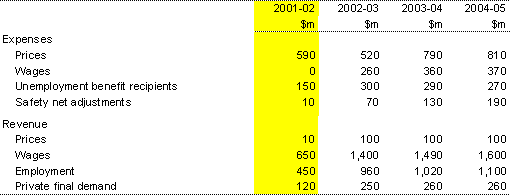
On the expenses side, the sensitivity analysis of the estimates provides for the following assumptions about changes to four broad groups of parameters. An increase in any of the parameters considered will lead to an increase in expenses, and a decrease in any of the parameters will lead to a reduction in expenses.
Prices
All price deflators are assumed to change by one percentage point at the start of the March quarter 2002, with wage deflators left unchanged.
- The effect of a change in prices is due to the indexation of Commonwealth expenses and a change in the nominal superannuation interest expense.
Wages
All wage and salary growth rates are assumed to change by one percentage point from the beginning of the March quarter 2002, with price deflators left unchanged.
- The effect of a change in wage and salary growth rates is largely determined by the effect of the Government's commitment to maintain selected pensions at 25 per cent of Male Total Average Weekly Earnings. The wages effect in Table D1 above does not include the effect of changes to wage and salary payments on Commonwealth departmental expenses.
Unemployment benefit recipients (includes Newstart Allowance and unemployed Youth Allowance recipients)
The total number of recipients is assumed to change by 5 per cent in the Budget year and in all the forward years.
Safety Net Adjustment
The Safety Net Adjustment (SNA) determined by the Australian Industrial Relations Commission (AIRC) is assumed to change by $2 per week from the beginning of the March quarter in each year.
- About $45 billion of expenses, comprising agency departmental expenses, other Commonwealth Own Purpose Expenses and Specific Purpose Payments to the States of a departmental expense nature, are indexed to weighted averages of movements in inflation and the SNA.
On the revenue side, the sensitivity analysis of the estimates provides for the following assumptions about changes to four broad groups of parameters. An increase in any of the parameters considered will lead to an increase in revenue, and a decrease in any of the parameters will lead to a reduction in revenue.
Prices and wages
The assumptions underlying the sensitivity of the revenue estimates to changes in prices and wages are similar to those used for expenses.
- The effect of a change in prices affects revenue primarily through changes in excise revenue.
- The effect of a change in wages affects revenue predominantly through changes in PAYG withholding tax and FBT revenue.
Employment
The level of employment is assumed to change by one percentage point from the beginning of the March quarter 2002, with no change in the composition of demand.
- The effect of a change in employment feeds through into tax revenue largely through increases in PAYG withholding tax collections.
Private final demand
The level of private final demand (consumption plus investment) is assumed to change by one percentage poi
nt from the beginning of the March quarter 2002, with no change in the composition of demand.
- The effect of a change in private final demand affects revenue predominantly through changes in excise and customs duty collections.